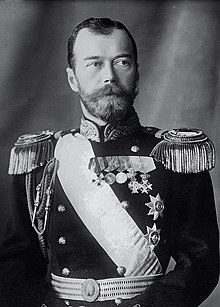

Emperor of All Russia
18 May O.S. 6 May 1868 Alexander Palace, Tsarskoye Selo, Russian Empire
17 July 1918(1918-07-17) (50) Ipatiev House, Yekaterinburg, Russian Soviet Republic
NamesNikolai Alexandrovich Romanov
Tsar of the Russian Empire (reigned 1894–1917); overthrown in the Russian Revolution "Nicholas II" redirects here. For other uses, see Nicholas II (disambiguation). Nicholas IINicholas II in 1912Emperor of All RussiaReign1 November 1894 – 15 March 1917 Coronation26 May 1896PredecessorAlexander IIISuccessorMonarchy abolished Georgy Lvov (as Minister-Chairman)Prime Minister See listBorn18 May 1868 Alexander Palace, Tsarskoye Selo, Russian EmpireDied17 July 1918(1918-07-17) (aged 50) Ipatiev House, Yekaterinburg, Russian Soviet RepublicBurial17 July 1998 Peter and Paul Cathedral, Saint Petersburg, Russian FederationSpouseAlexandra Feodorovna (Alix of Hesse) (m. 1894 )Issue Grand Duchess Olga Grand Duchess Tatiana Grand Duchess Maria Grand Duchess Anastasia Tsesarevich Alexei NamesNikolai Alexandrovich RomanovHouseHolstein-Gottorp-RomanovFatherAlexander III of RussiaMotherMaria Feodorovna (Dagmar of Denmark)ReligionRussian OrthodoxSignature Saint Nicholas II of RussiaPassion-BearerVenerated inEastern OrthodoxyCanonized1981 by Russian Orthodox Church Abroad2000 by the Russian Orthodox ChurchMajor shrine Church on Blood, Yekaterinburg, RussiaFeast17 July Nicholas II or Nikolai II Alexandrovich Romanov (18 May 1868 – 17 July 1918), known in the Russian Orthodox Church as Saint Nicholas the Passion-Bearer, was the last Emperor of Russia, King of Poland and Grand Duke of Finland, ruling from 1 November 1894 until his abdication on 15 March 1917. During his reign, Nicholas gave support to the economic and political reforms promoted by his prime ministers, Sergei Witte and Pyotr Stolypin. He advocated modernization based on foreign loans and close ties with France, but resisted giving the new parliament (the Duma) major roles. Ultimately, progress was undermined by Nicholas's commitment to autocratic rule, strong aristocratic opposition and defeats sustained by the Russian military in the Russo-Japanese War and World War I. By March 1917, public support for Nicholas had collapsed and he was forced to abdicate the throne, thereby ending the Romanov dynasty's 304-year rule of Russia (1613–1917). Nicholas signed the Anglo-Russian Convention of 1907, which was designed to counter Germany's attempts to gain influence in the Middle East; it ended the Great Game of confrontation between Russia and the British Empire. He aimed to strengthen the Franco-Russian Alliance and proposed the unsuccessful Hague Convention of 1899 to promote disarmament and solve international disputes peacefully. Domestically, he was criticised for his government's repression of political opponents and his perceived fault or inaction during the Khodynka Tragedy, anti-Jewish pogroms, Bloody Sunday and the violent suppression of the 1905 Russian Revolution. His popularity was further damaged by the Russo-Japanese War, which saw the Russian Baltic Fleet annihilated at the Battle of Tsushima, together with the loss of Russian influence over Manchuria and Korea and the Japanese annexation of the south of Sakhalin Island. During the July Crisis, Nicholas supported Serbia and approved the mobilization of the Russian Army on 30 July 1914. In response, Germany declared war on Russia on 1 August 1914 and its ally France on 3 August 1914, starting the Great War, later known as the First World War. The severe military losses led to a collapse of morale at the front and at home; a general strike and a mutiny of the garrison in Petrograd sparked the February Revolution and the disintegration of the monarchy's authority. After abdicating for himself and his son, Nicholas and his family were imprisoned by the Russian Provisional Government and exiled to Siberia. After the Bolsheviks took power in the October Revolution, the family was held in Yekaterinburg, where they were executed on 17 July 1918. In 1981, Nicholas, his wife, and their children were recognized as martyrs by the Russian Orthodox Church Outside Russia, based in New York City. Their gravesite was discovered in 1979, but this was not acknowledged until 1989. After the fall of the Soviet Union, the remains of the imperial family were exhumed, identified by DNA analysis, and re-interred with an elaborate state and church ceremony in St. Petersburg on 17 July 1998, exactly 80 years after their assassination. They were canonized in 2000 by the Russian Orthodox Church as passion bearers. In the years following his death, Nicholas was reviled by Soviet historians and state propaganda as a "callous tyrant" who "persecuted his own people while sending countless soldiers to their deaths in pointless conflicts". Despite being viewed more positively in recent years, the majority view among historians is that Nicholas was a well-intentioned yet poor ruler who proved incapable of handling the challenges facing his nation.

We use cookies
We use cookies and other tracking technologies to improve your browsing experience on our website, to show you personalized content and targeted ads, to analyze our website traffic, and to understand where our visitors are coming from. Privacy Policy.